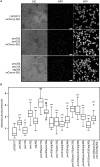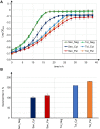Production of the Fragrance Geraniol in Peroxisomes of a Product-Tolerant Baker's Yeast
- PMID: 33102464
- PMCID: PMC7546902
- DOI: 10.3389/fbioe.2020.582052
Production of the Fragrance Geraniol in Peroxisomes of a Product-Tolerant Baker's Yeast
Abstract
Monoterpenoids, such as the plant metabolite geraniol, are of high industrial relevance since they are important fragrance materials for perfumes, cosmetics, and household products. Chemical synthesis or extraction from plant material for industry purposes are complex, environmentally harmful or expensive and depend on seasonal variations. Heterologous microbial production offers a cost-efficient and sustainable alternative but suffers from low metabolic flux of the precursors and toxicity of the monoterpenoid to the cells. In this study, we evaluated two approaches to counteract both issues by compartmentalizing the biosynthetic enzymes for geraniol to the peroxisomes of Saccharomyces cerevisiae as production sites and by improving the geraniol tolerance of the yeast cells. The combination of both approaches led to an 80% increase in the geraniol titers. In the future, the inclusion of product tolerance and peroxisomal compartmentalization into the general chassis engineering toolbox for monoterpenoids or other host-damaging, industrially relevant metabolites may lead to an efficient, low-cost, and eco-friendly microbial production for industrial purposes.
Keywords: Saccharomyces cerevisiae; compartmentalization; geraniol; monoterpenoids; peroxisomes; tolerance.
Copyright © 2020 Gerke, Frauendorf, Schneider, Wintergoller, Hofmeister, Poehlein, Zebec, Takano, Scrutton and Braus.
Figures





Similar articles
-
Monoterpenoid biosynthesis by engineered microbes.J Ind Microbiol Biotechnol. 2021 Dec 23;48(9-10):kuab065. doi: 10.1093/jimb/kuab065. J Ind Microbiol Biotechnol. 2021. PMID: 34601590 Free PMC article. Review.
-
Recent Advances on Feasible Strategies for Monoterpenoid Production in Saccharomyces cerevisiae.Front Bioeng Biotechnol. 2020 Dec 1;8:609800. doi: 10.3389/fbioe.2020.609800. eCollection 2020. Front Bioeng Biotechnol. 2020. PMID: 33335897 Free PMC article. Review.
-
De novo production of the monoterpenoid geranic acid by metabolically engineered Pseudomonas putida.Microb Cell Fact. 2014 Dec 4;13:170. doi: 10.1186/s12934-014-0170-8. Microb Cell Fact. 2014. PMID: 25471523 Free PMC article.
-
Esterification of geraniol as a strategy for increasing product titre and specificity in engineered Escherichia coli.Microb Cell Fact. 2019 Jun 8;18(1):105. doi: 10.1186/s12934-019-1130-0. Microb Cell Fact. 2019. PMID: 31176369 Free PMC article.
-
Monoterpenoid biosynthesis in Saccharomyces cerevisiae.FEMS Yeast Res. 2007 May;7(3):413-21. doi: 10.1111/j.1567-1364.2006.00172.x. Epub 2006 Nov 9. FEMS Yeast Res. 2007. PMID: 17096665
Cited by
-
De Novo Biosynthesis of Vindoline and Catharanthine in Saccharomyces cerevisiae.Biodes Res. 2022 Dec 26;2022:0002. doi: 10.34133/bdr.0002. eCollection 2022. Biodes Res. 2022. PMID: 37905202 Free PMC article.
-
Monoterpenoid biosynthesis by engineered microbes.J Ind Microbiol Biotechnol. 2021 Dec 23;48(9-10):kuab065. doi: 10.1093/jimb/kuab065. J Ind Microbiol Biotechnol. 2021. PMID: 34601590 Free PMC article. Review.
-
ML-enhanced peroxisome capacity enables compartmentalization of multienzyme pathway.Nat Chem Biol. 2025 May;21(5):727-735. doi: 10.1038/s41589-024-01759-2. Epub 2024 Oct 14. Nat Chem Biol. 2025. PMID: 39402374
-
Engineering Yarrowia lipolytica for the biosynthesis of geraniol.Metab Eng Commun. 2023 Nov 2;17:e00228. doi: 10.1016/j.mec.2023.e00228. eCollection 2023 Dec. Metab Eng Commun. 2023. PMID: 38029016 Free PMC article.
-
Compartmentalization and transporter engineering strategies for terpenoid synthesis.Microb Cell Fact. 2022 May 23;21(1):92. doi: 10.1186/s12934-022-01819-z. Microb Cell Fact. 2022. PMID: 35599322 Free PMC article. Review.
References
LinkOut - more resources
Full Text Sources
Molecular Biology Databases

